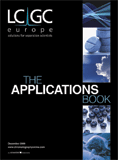UHPLC Separation of Triazine Herbicides at Elevated Temperature
The Application Notebook
Increase throughput of the HPLC method for triazine herbicides by employing ultra high-speed liquid chromatography at elevated temperature on a heat stable Thermo Scientific Hypercarb column.
Goal
Increase throughput of the HPLC method for triazine herbicides by employing ultra high-speed liquid chromatography at elevated temperature on a heat stable Thermo Scientific Hypercarb column.
Introduction
Temperature is a key variable in high performance liquid chromatography (HPLC), influencing solute diffusion rates, mobile phase viscosity and solubility. For example, as column temperature increases, analyte diffusion increases. Increased analyte diffusion generally leads to an increase in the optimum linear velocity of the separation, so that equivalent chromatographic efficiency and resolution can be achieved at a higher flow rate. Furthermore, elevating the temperature reduces the operating backpressure. The net result is that separations can be performed faster without exceeding the pressure limitations of the instrument.
This application uses a porous graphitic carbon stationary phase thermostatted in a high temperature column oven to separate triazine herbicides 5 to 10 times faster than is typical with conventional HPLC. The triazines and degradation products are separated on the Thermo Scientific Accela high speed liquid chromatograph in 2 minutes on a Hypercarb 3 µm, 1 x 100 mm column operated at 160 °C. This application note also documents the performance of the high temperature liquid chromatographic method, including precision of retention time and peak area, resolution and spike recovery from several environmental water matrices.
Mobile Phase
Proportioned mobile phase: Filled solvent reservoir bottle A of the Accela pump with fresh HPLC-grade water and purged the solvent line with at least 30 mL of the water. Connected a fresh bottle of HPLC-grade acetonitrile to reservoir B and purged as above.
Calibration Standards
Individual stock solutions, 1000 mg/L: Accurately weighed 10 mg (0.010 g) of each neat compound into a 10 mL volumetric flask, added 5 mL acetonitrile and sonicated to dissolve. Brought to volume with acetonitrile and mix. Used desethyl atrazine, deisopropyl atrazine and propanil, purchased as solutions of 1000 mg/L in methanol, as received.
Combined intermediate standard 100 mg/L: Used a calibrated pipette to deliver 1000 µL of each individual stock solution to a 10 mL volumetric flask. Brought to volume with acetonitrile and mix.
Calibration standards: Used a calibrated pipette to dilute the intermediate standard with mobile phase in volumetric glassware to 30, 10, 3, 1, 0.3, 0.1 and 0.03 mg/L.
Samples
Samples of surface water (Salinas River, Monterey County, California, USA), ground water (domestic well, Santa Cruz county, California, USA), and drinking water (San Jose, California, USA tap water) were collected in accordance with established procedures, stored at 4–8 °C, and were filtered through a 0.45 µm nylon syringe filter into a glass autosampler vial before analysis.
System Preparation
To ensure good performance of this application, prepare the system as directed in appendix A of the full Application Note 453.
Results
Separation of seven triazine herbicides, two triazine degradation products often found in environmental samples and propanil is shown in Figure 1.

Figure 1
To optimize this separation, we adjusted the mobile phase composition to elute the first analyte with a capacity factor k' > 2, thereby improving resolution of the target analytes from sample matrix junk. Analytes spanning a wide range of polarity are well resolved by the combination of high temperature, solvent gradient and the selectivity of the Hypercarb stationary phase. Note that because of the reduced viscosity of the mobile phase at 160 °C, this separation occurs at a linear flow rate of 15 mm/s — equivalent to a flow rate of over 10 mL/min on a 4.6 mm i.d. column. The system backpressure under these conditions is less than 4000 psi (272 bar).
Method performance is characterized by peak resolution, linear calibration range, limits of detection and precision of retention time and peak area. MDLs for each analyte were determined by performing seven replicate injections of LC–MS-grade water fortified at a concentration of three to five times the estimated instrument detection limits and calculating the standard deviation of the measured concentration. Good precision of retention time and peak area reflects the temperature stability maintained by the high temperature oven.
Several environmental water samples were analysed to demonstrate the efficacy of this method with real matrices. Samples of surface, ground and municipal drinking water were analysed before and after fortification with a known amount of each target analyte. Spike recovery was calculated as the amount of each analyte found in the spiked sample divided by the amount expected (i.e., the amount determined in the blank plus the amount added in the spike). Even with the dirtiest matrix, Salinas river water, the target analytes are well separated from the early eluting matrix peaks and recovery of the spiked analytes exceeds 80%.
Conclusion
A separation performed at 160 °C on the Accela high speed chromatography system equipped with a heat stable Hypercarb column and high temperature column oven resolves 11 triazine herbicides in about two minutes with retention time and peak area precision better than 1% RSD for 30 replicates.
Hypercarb and Accela are registered trademarks of Thermo Fisher Scientific.

Thermo Fisher Scientific Inc.
355 River Oaks Parkway, San Jose, California 95134, USA
tel. +1 561 688 8900 fax +1 608 273 6880
E-mail: analyze@thermo.com
Website: www.thermo.com

Pick Your Poison. Isolation of Paclitaxel (Mar 2025)
March 7th 2025The diterpenoid, paclitaxel, which was identified as a potent chemotherapy agent for breast and ovarian cancer originates from the Pacific Yew tree. The isolation of paclitaxel from its major impurities is shown with the use of Hamilton’s PRP-1 (5 µm) HPLC column.














